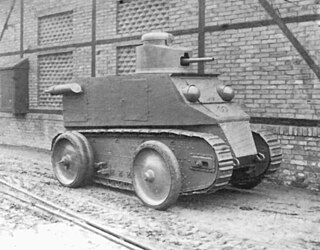 W
WThis article deals with the history of tanks employed by military forces in Czechoslovakia from the interwar period, and the more conventional tanks designed for the Czech Army before World War II, and the tanks that ended up as Panzers of the German Wehrmacht during World War II, or in the use of other countries who purchased them before the war began.
 W
WThe Turán was a Hungarian medium tank of World War II. It was inspired and used the technology-based solutions found on the design of the Czechoslovak Škoda T-21 medium tank prototype, it was produced in two main variants: the 40M Turán with a 40 mm gun and the 41M Turán with a 75 mm gun. A total of 424 were made.
 W
WThe AH-IV was a Czechoslovak-designed tankette used by Romania, Sweden and Iran during World War II. The Romanian vehicles saw action on the Eastern Front from Operation Barbarossa to the Vienna Offensive. Twenty vehicles were sold to Ethiopia after the war who used them until the Eighties. Romania also created a prototype, called R-1-a.
 W
WKolohousenka was a series of Czechoslovakian wheeled and tracked light tanks developed by Skoda, ČKD and Tatra.
 W
WThe LT vz. 34, formally designated as Lehký tank vzor 34 was a Czechoslovak-designed light tank used mainly by Slovakia during World War II. Its suspension was based on that of the Carden-Loyd tankette, of which the Czechs had purchased three, plus a manufacturing license, in 1930. Dissatisfied with the prototypes of the Tančík vz. 33 tankette, the Czech Army decided that it would be easier to design a light tank from scratch rather than modify a tankette's chassis to carry a fully rotating armored turret. 50 were built, the last of which was delivered during 1936, of which the Germans captured 22 - including the prototype, when they occupied Bohemia-Moravia in March 1939, but they promptly scrapped them. The Slovaks seized the remaining 27 when they declared independence from Czechoslovakia at the same time. In Slovak service it only saw combat during the Slovak National Uprising.
 W
WThe MT-55A is an armoured vehicle-launched bridge (AVLB) tank, manufactured by ZTS Martin in Slovakia. The AVLB is based on a T-55A medium tank chassis, with the turret detached and replaced by a special bridge launching equipment.
 W
WThe Panzerkampfwagen 38(t), originally known as the ČKD LT vz. 38 was a tank designed during the 1930s, which saw extensive service during World War II. Developed in Czechoslovakia by ČKD, the type was adopted by Nazi Germany following the annexation of Czechoslovakia. With the German Army and other Axis forces, the type saw service in the invasions of Poland, France and the USSR. Production ended in 1942, when its main armament was deemed inadequate. In all, over 1,400 Pz. 38(t)s were manufactured. The chassis of the Pz. 38(t) continued to be produced for the Marder III (1942–1944) with some of its components used in the later Jagdpanzer 38 (1944–1945) tank destroyers and its derivative vehicles.
 W
WThe T-54/T-55 tank series is the most widely used tank in the world and has seen service in over 50 countries. It has also served as the platform for a wide variety of specialty armored vehicles.
 W
WThe T-54/T-55 tank series is the most widely used tank in the world and has seen service in over 50 countries. It has also served as the platform for a wide variety of specialty armored vehicles.
 W
WThe T-72 is a Soviet-designed main battle tank that entered production in 1971. It replaced the T-54/55 series as the workhorse of Soviet tank forces. In front-line Russian service, T-72s are being upgraded or augmented by the T-90. The T-72 has been exported and produced in many countries.
 W
WThe T-72 is a Soviet-designed main battle tank that entered production in 1971. It replaced the T-54/55 series as the workhorse of Soviet tank forces. In front-line Russian service, T-72s are being upgraded or augmented by the T-90. The T-72 has been exported and produced in many countries.
 W
WThe Tančík vz. 33 was a Czechoslovak-designed tankette used mainly by Slovakia during World War II. Seventy-four were built. The Germans seized forty when they occupied Bohemia-Moravia in March 1939; there is no record of their use. The Slovak Republic inherited thirty at the same time when it declared independence from Czechoslovakia. In Slovak service it only saw combat during the Slovak National Uprising.
 W
WV-8-H, also known as ST vz. 39, was a Czechoslovak medium tank developed by ČKD in the late 1930s. Only two prototypes were ever built.